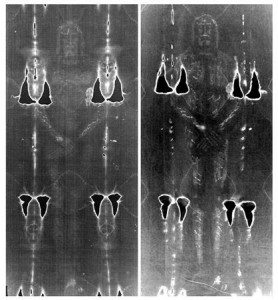Luigi Garlaschelli, an organic chemistry professor at the University of Pavia, says he has reproduced the Shroud of Turin using only materials and techniques available in the Middle Ages.
The Shroud of Turin is said to be the sheet in which Jesus was wrapped after the Crucifixion. It bears an image of a bearded man, with wounds on his head, wrists, feet and side.
In 1988, three independent laboratories radiocarbon-dated it to between 1260 and 1390 A.D. This set off a major controversy and some people questioned whether the small samples taken from the edges of the cloth could have been contaminated from hundreds of years of handling. (The Church itself took no stand on the question and never has. The shroud is a symbol of the Passion of Christ, as far as they’re concerned, and they leave it at that.)
Before then, in 1978, a team of American scientists from NASA, the Navy and a variety of universities and research agencies carefully examined the shroud. They found microscopic protein evidence that the linen came from the first century Middle East.
They also found that the bloodstains were in fact blood, and that the image wasn’t made of paint or pigment. Scientists still haven’t been able to pin down exactly how the image on the linen might have been created at that time.
Enter Garlaschelli and his team.
They placed a linen sheet flat over a volunteer and then rubbed it with a pigment containing traces of acid. A mask was used for the face.
The pigment was then artificially aged by heating the cloth in an oven and washing it, a process which removed it from the surface but left a fuzzy, half-tone image similar to that on the Shroud. He believes the pigment on the original Shroud faded naturally over the centuries.
They then added blood stains, burn holes, scorches and water stains to achieve the final effect.
It looks pretty damn good, I must say. The original is on the left, the reproduction on the right.

Of course this doesn’t prove anything other than that it was physically possible for people to have rigged themselves up a miraculous shroud in the Middle Ages. As Garlaschelli notes, folks who don’t believe the carbon dating results from some of the most reputable labs in the world aren’t likely to believe him either.
The study was also funded by an Italian association of atheists and agnostics, so people who don’t trust their motivations and Garlaschelli’s integrity obviously will not trust the findings.
The Shroud of Turin is kept out of sight most of the time. In the past 300 years, it has only been viewable by the public 17 times. The last time it was on public display was in 2000. To catch a rare glimpse of the Shroud of Turin, make your way to the Guarini Chapel in the Turin Cathedral next year between April 10 and May 23.
Fun fact: a displaying of the Shroud actually has a name. It’s called an “ostensione” — an ostentation in English — after the shameless way in which the royal house of Savoy showed it off back in the late 16th/early 17th century when they first got it.